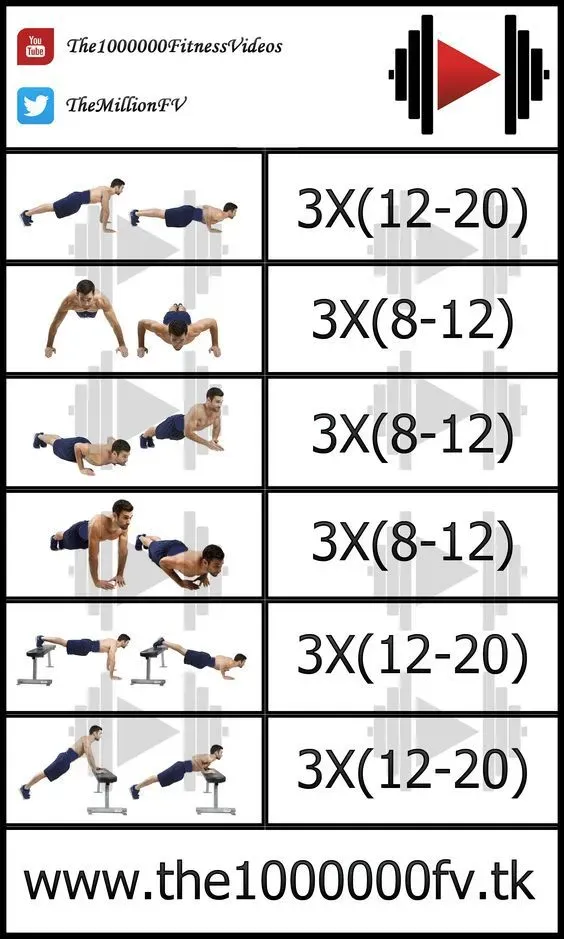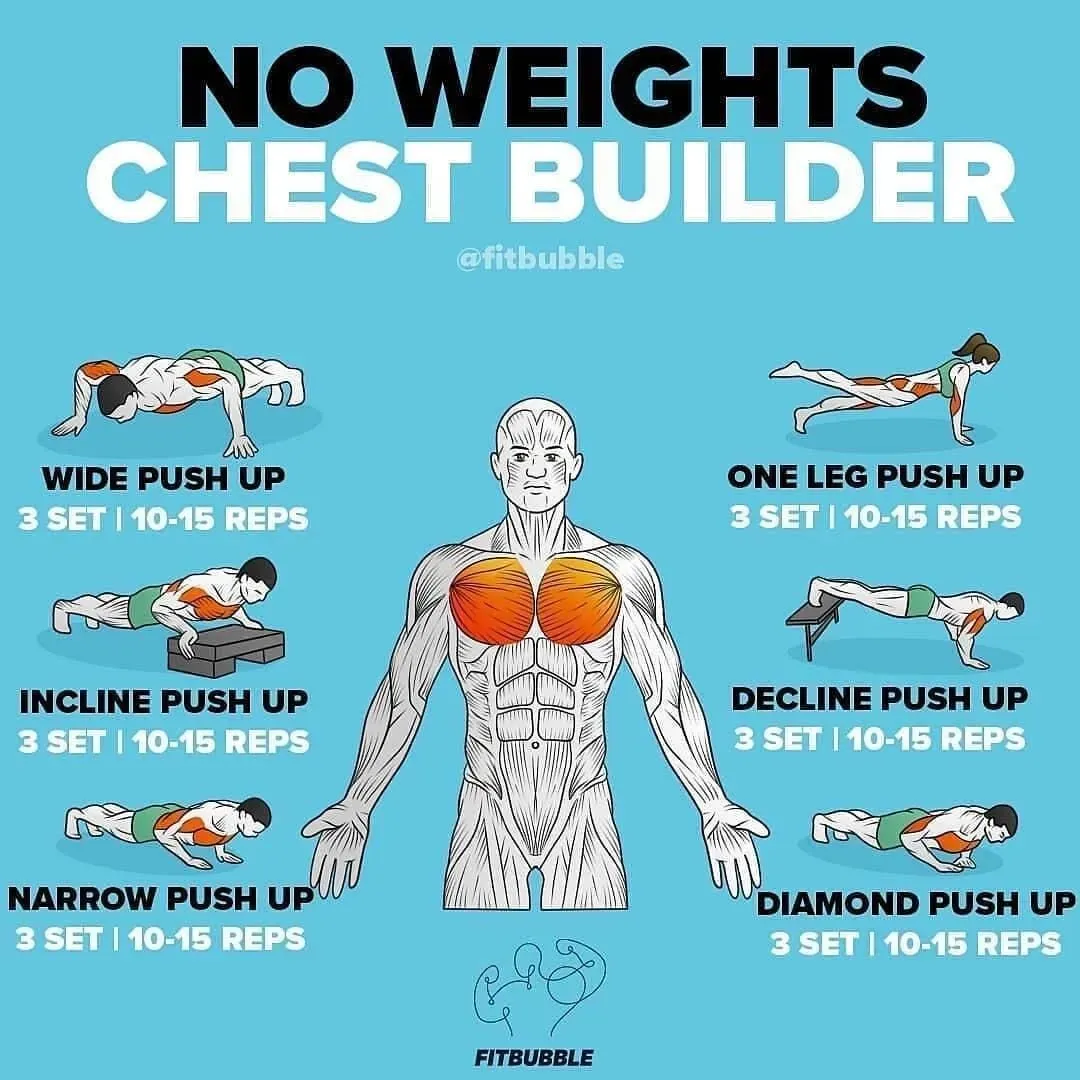Table of Contents
Tired of looking in the mirror and seeing, well, not much going on in the chest department? Maybe the gym isn't your scene, or life just keeps getting in the way. You've probably wondered if building a solid chest is even possible without racks of weights and fancy machines. Let's cut to the chase: Yes, you absolutely can build a strong, defined chest right from your living room floor. Forget the excuses about needing a fully equipped gym. Your body is the only machine you need.
Why Bother with a Chest Workout at Home Without Equipment Chart?

Why Bother with a Chest Workout at Home Without Equipment Chart?
Ditch the Gym Commute, Keep the Gains
Look, life's messy. Sometimes getting to the gym feels like a whole second job. Traffic, crowded benches, waiting for equipment – it all adds up. The beauty of a chest workout at home without equipment chart is that it strips away all those barriers. Your living room becomes the gym. Your schedule dictates the workout, not the other way around. You save time, you save money on membership fees, and frankly, you can wear whatever you want (or nothing at all, I'm not judging). It’s about making fitness fit into *your* life, not trying to squeeze yourself into the gym's mold.
Structure and Progress Without the Steel
Maybe you think bodyweight is just for beginners. That's a tired old myth. The human body is capable of incredible strength using just its own weight. The challenge isn't the lack of external load; it's knowing *how* to apply your bodyweight effectively and progressively. That's where a structured chest workout at home without equipment chart comes in. It takes the guesswork out of it. It provides a clear path, showing you variations and progressions that keep challenging your muscles, forcing them to adapt and grow, just like they would under a barbell. It’s not just doing push-ups; it’s doing the *right* push-ups in the *right* sequence.
So, why use a chart specifically?
- Provides clear progression paths.
- Ensures balanced muscle engagement.
- Helps track your improvement.
- Removes decision fatigue before workouts.
- Offers variety to prevent plateaus.
The Science of Bodyweight Pec Building

The Science of Bodyweight Pec Building
It's Not Magic, It's Mechanics
So, how exactly do push-ups build a chest? It's not some ancient secret; it's basic muscle physiology. When you perform a push-up, you're applying resistance to your pectoral muscles (pec major and minor), your front shoulders (anterior deltoids), and your triceps. This resistance causes tiny tears in the muscle fibers. Sounds bad, right? It's not. When your body repairs these tears, it overcompensates, making the fibers thicker and stronger. This process, called hypertrophy, is the bedrock of muscle growth. Your body doesn't care if the resistance comes from a fancy machine or the floor; it just responds to the stimulus.
Targeting Angles for Full Pec Development
Thinking push-ups only hit one spot? Think again. By simply changing the angle of your body relative to the floor, you can shift the emphasis and hit different parts of your chest. Elevating your feet (decline push-ups) targets the lower pec fibers more intensely. Elevating your hands (incline push-ups) works the upper chest and shoulders. Bringing your hands closer together (diamond push-ups) puts more load on the inner chest and triceps. Wider hand placement hits the outer chest. It's about manipulating leverage and range of motion to challenge the muscle fibers from various angles, ensuring balanced development.
Want to know which push-up hits which area hardest?
- Standard Push-ups: Overall chest, shoulders, triceps.
- Incline Push-ups: Upper chest, shoulders.
- Decline Push-ups: Lower chest, shoulders.
- Diamond Push-ups: Inner chest, triceps.
- Wide Push-ups: Outer chest.
Your Chest Workout at Home Without Equipment Chart: Essential Moves
Starting Strong: The Foundation of Your Chart
Alright, let's get down to brass tacks. Your chest workout at home without equipment chart isn't going to be filled with secret ninja moves nobody's ever heard of. It starts with the basics, mastered. We're talking push-ups, yes, but done right and with purpose. Think of the standard push-up as your bread and butter. Hands slightly wider than shoulder-width, fingers pointing forward, body a straight line from head to heels. Lower your chest towards the floor, keeping elbows tucked slightly (not flaring out like chicken wings), then press back up. This hits the whole chest, shoulders, and triceps efficiently. It's the cornerstone. You build everything else on this.
Adding Layers: Variations for Targeted Growth
Once you own the standard push-up, it's time to get creative and tailor your chest workout at home without equipment chart. Remember how changing angles matters? Incline push-ups (hands on a raised surface like a chair or counter) make it easier, perfect if standard push-ups are too tough right now. Decline push-ups (feet on a raised surface) crank up the difficulty and hammer the lower chest. Diamond push-ups (hands close together forming a diamond shape) are brutal on the inner chest and triceps – a real test of strength. Wide push-ups emphasize the outer sweep of the pecs. These variations aren't just for show; they allow you to manipulate intensity and target specific muscle fibers, making your bodyweight routine incredibly versatile.
Here’s a simple look at how you might structure the start of your chart:
- Warm-up: Arm circles, light stretching (5 mins)
- Exercise 1: Standard Push-ups (Sets: 3-4, Reps: As many as possible with good form)
- Exercise 2: Incline Push-ups (Sets: 3, Reps: 10-15)
- Exercise 3: Diamond Push-ups (Sets: 3, Reps: 5-10, or to failure)
- Rest: 60-90 seconds between sets
Structuring Your Chest Workout at Home Without Equipment Routine

Structuring Your Chest Workout at Home Without Equipment Routine
Consistency is King (and Queen) for Home Gains
Alright, so you've got your essential moves down from your chest workout at home without equipment chart. Now, how do you actually put it all together into something that gets results? Think of it like building a house; you need a blueprint and you need to show up every day to lay bricks. Consistency is non-negotiable here. You can have the best exercises in the world, but if you're just doing them randomly whenever you feel like it, you're leaving gains on the table. Decide how many days a week you'll train your chest – maybe two or three, allowing rest in between. Stick to those days. Having a set schedule makes it a habit, not a chore you might skip when Netflix is calling.
Making Progress When There's No More Weight
The biggest question people have about a chest workout at home without equipment chart is, "How do I get stronger or bigger if I can't add more weight?" This is where progressive overload comes in, bodyweight style. You don't add plates, you make the exercise harder. How? Increase the reps per set. Do more sets. Decrease the rest time between sets. Most effectively, change the leverage or stability. Moving from incline push-ups to standard, then to decline, then maybe even to one-arm push-ups (eventually!) are all forms of progressive overload. You're increasing the demand on the muscle over time, which is the fundamental driver of growth and strength.
How can you make bodyweight chest exercises harder?
- Increase repetitions per set.
- Add more sets to your workout.
- Reduce rest time between sets.
- Move to more difficult variations (e.g., standard to decline push-ups).
- Increase time under tension (slower negatives, pauses).
- Incorporate plyometric variations (clapping push-ups).
- Train to closer proximity to failure.
Pushing Past Plateaus: Advanced Bodyweight Chest Training

Pushing Past Plateaus: Advanced Bodyweight Chest Training
Breaking the Wall: When Standard Push-ups Aren't Enough
So, you've been crushing your chest workout at home without equipment chart, consistently hitting your reps, maybe even adding a few extra sets. But lately? Nothing. The numbers aren't moving, the pump isn't the same, and frankly, you're getting a bit bored. Welcome to the plateau. It happens to everyone, whether you're lifting heavy metal or just your own body weight. Your muscles are smart; they adapt to the stimulus you give them. If the stimulus stays the same, the adaptation stops. It's like telling your brain the same joke every day – eventually, it just doesn't land anymore. You need to change the joke, or in this case, change the exercise.
Turning Up the Heat: Advanced Bodyweight Techniques
This is where the real fun begins with your chest workout at home without equipment chart. Breaking plateaus means introducing a new, more challenging stimulus. Since you can't add weight, you add complexity and intensity. Think unilateral movements like Archer push-ups or even working towards one-arm push-ups – these dramatically increase the load on one side of the chest. Plyometric push-ups (like clapping push-ups) build explosive power. Deficit push-ups (hands on blocks or books) increase the range of motion, forcing a deeper stretch at the bottom. These variations aren't just harder; they recruit muscle fibers differently and demand more from your stabilizers. They inject novelty and serious challenge back into your routine.
Ready to level up? Consider these advanced moves:
- Archer Push-ups (working towards one-arm)
- Plyometric Push-ups (Clapping, Chest Slap)
- Deficit Push-ups (using books or blocks)
- Pseudo Planche Push-ups (hands lower, closer to hips)
- Typewriter Push-ups (moving side-to-side at the bottom)
- Single-Leg Push-ups (adds instability)
Your Chest, Forged at Home
So there you have it. Building a formidable chest without ever stepping foot in a gym isn't just some fitness fantasy; it's entirely achievable with the right approach and consistent effort. The chest workout at home without equipment chart isn't a magic bullet, but a solid foundation. It provides the structure, the variations, and the progression you need to challenge your muscles and force growth. Stop waiting for the perfect time or the perfect equipment. The time is now, and the equipment is you. Put in the work, and you'll see results.
